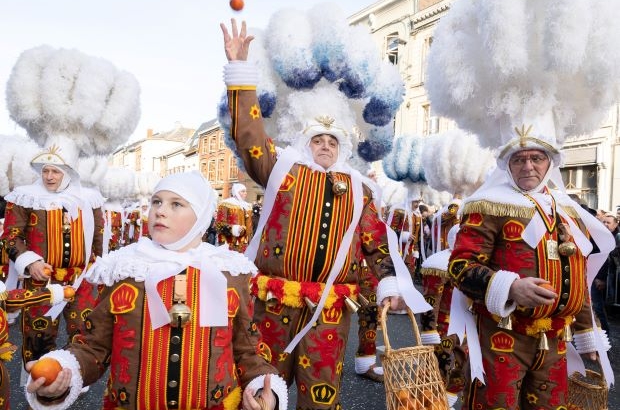- Daily & Weekly newsletters
- Buy & download The Bulletin
- Comment on our articles
Carnival countdown: The Belgian town of Binche gets ready to party!
Strap on your bells, dust off your ostrich plumes, carnival season is here! The popular festivals are being staged all over the country: colourful parades, costumes and eager crowds who will be partying on until Easter.
Beyond the feasting, drinking, throwing oranges and mocking the powerful, Belgium’s carnival tradition is bound up in a mishmash of Catholic and pagan rites combined with an anarchic rebellion against strict social order.
That’s why the tradition in Binche is recognised as world heritage by Unesco.

For 2024, the Hainaut town is celebrating a double anniversary: it’s 20 years since it received the prestigious Unesco ranking and 900 years since the medieval settlement was founded.
So from 11 to 13 February, Binche will be making merry. As ever, the three-day festivities occur before the start of Lent and are centred on Shrove Tuesday in a reflection of their Christian tradition. A heathenish scaring off of winter evokes a more pagan past.
The imminent period of fasting is one reason why they involve excessive eating and drinking. The other important thread is the overturning of social order. Carnival was the one moment in the year when ordinary people could throw off their usual constraints, quaff Champagne and pelt crowds with oranges – luxury items otherwise beyond their purse.
While the Binche carnival tradition harks back to at least the 16th century and Spanish rule, many of the customs and costumes date from the late 19th century. Whatever their origins, the popularity of these folklore parties never wanes.

Meet the Gilles of Binche and their ancient rituals and customs
First there is the sound – the rhythmic, hypnotic stamping of clogs on cobbled stones, accompanied by the jangle of brass bells on belts and the beating of drums – then the visual panorama of colour and movement as the Gilles perform their ritual carnival dance.
About 1,000 revellers supported by family and friends join in the tradition, from the cadenced shuffle to the pelting of oranges, making this the oldest and most authentic carnival celebration in Belgium. As preserved as the town’s 12th-century ramparts, the carnival of Binche enjoys worldwide fame.
The event is deeply rooted in the social fabric of the town that lies deep in a former industrial wasteland. Most families in the tight-knit 30,000-strong community can count at least one highly honoured Gilles or member of one of the 13 groups that make up the procession and festivities. This membership – restricted to men – is likened to a virus, which may explain the commitment and financial cost of being a Gilles as the elaborate costumes need to be rented every year.
Preparations are a year-round affair leading to an intense rehearsal period six Sundays before the three-day Mardi Gras. These public practice sessions for the drummers and musicians are followed by soumonces, when they are joined by brass instruments and perform in local cafés.

This warming-up period is but a prelude to the celebrations, which kick off on the Saturday before Carnival with three costumed balls for the town’s youngsters: Catholic, liberal and socialist, representing the pillars of Belgian political and social life. They are followed on Monday by the Trouilles de nouilles, when mysterious masked revellers invade the town to inflict their wit in return for beer. Finally, after weeks of mounting madness, it’s time for the three Gras days. Sunday is colourful, starting with the future Gilles parading in fantasy costume, plus a spot of cross-dressing with men disguised as women, or Mam’zèlles. Monday is for the children, traditionally a day for locals to catch their breath away from the gaze of tourists.
On Tuesday, it is the turn of the Gilles, the carnival kings who tradition dictates must be Binche-born. Early before dawn, it’s the role of the women in their family to ritually and proudly dress them in the linen shirts and trousers, stuffed back and front with straw and adorned with about 200 motifs in the Belgian colours – typically, these are crowned lions and stars. The red and yellow belt is emblazoned with bells, wooden clogs adorn their feet and they are armed with a sheath of twigs, a symbol of the Gilles’ agricultural roots.

Finally, the drummer rounds up the Gilles from their homes. Strict rules apply and flouting them can bring a lifetime ban from the brotherhood: they must always be accompanied by a drummer and cannot step outside the city walls, travel in a car, kiss their wives, smoke or use a mobile phone. Another convention is the downing of champagne from daybreak, usually accompanied by oysters, throughout the festivities.
For the first few hours, they wear eerie wax masks adorned with signature green spectacles and curling ginger whiskers. The masks, artisan-made and patented, symbolise equality and anonymity. They are cast aside later in the day to be replaced by the ornate and towering ostrich-feather headdresses. And then battle commences as the orange-hurling ensues and the merrymaking persists late into the night, beyond the dazzling explosion of fireworks, forever to the rhythm of the beating drum.
Binche carnival
11-13 February
Find out more about Binche’s carnival tradition at the town’s Musée International du Carnaval et du Masque
More information on carnival celebrations in Wallonia here and across the country in The Bulletin’s weekly agenda here
Photos: ©Belga/Benoît Doppagne; Courtesy Carnaval de Binche
















